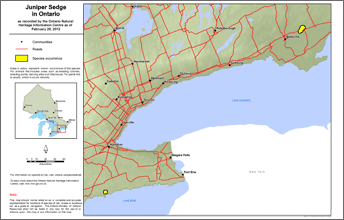Juniper sedge
Scientific name: Carex juniperorum

Cover photo credit: Wasyl Bakowsky
Status
Endangered
“Endangered” means the species lives in the wild in Ontario but is facing imminent extinction or extirpation.
Date added to the Species at Risk in Ontario List
The Juniper sedge was already assessed as endangered when the Endangered Species Act took effect in 2008.
What it looks like
Juniper Sedge is a small, perennial plant with grass-like leaves up to 30 centimetres long. It grows in colonies in open alvar woodland.
Alvar is a dry, open landform with very thin soil over a limestone bedrock base. It is one of the rarest habitat types in the world.
Where it lives
The Juniper Sedge grows mainly on alvars located in relatively open woodland, often dominated by red cedar but also deciduous trees.
At one site in Ontario, the species occurs in oak savannah. Drought and fire have a big role to play in keeping alvars and savannah in an open or semi-open condition.
Without such disturbances, this habitat would likely become overgrown by shrubs and trees that would shade-out the rare vegetation below.
Where it’s been found in Ontario
The Juniper Sedge is only found in southeastern Ontario and the southern Ohio-northern Kentucky region and is considered globally rare. In Canada, there are three sub-populations in Hastings County in the Salmon River Alvar.
One sub-population has been extirpated. Each sub-population contains 600 to 5000 shoots, some of which may actually be extensions of the same parent plant spreading by underground roots.
A small population was also recently discovered near Selkirk in Haldimand County. There are fewer than 20 known populations for this Juniper Sedge globally.
View a Larger version of this map (PDF)
What threatens it
The main threat to Juniper Sedge is habitat alteration, urban development, grazing, utility corridors, all-terrain vehicles, garbage dumping, and competition from non-native plants are also threats to this rare plant.
Action we are taking
Endangered Species and their general habitat are automatically protected
Habitat protection
General Habitat Protection - June 30, 2008
Recovery strategy
A recovery strategy advises the ministry on ways to ensure healthy numbers of the species return to Ontario.
Read the executive summary (June 25, 2015)
Read the recovery strategy (June 25, 2015)
Government response statement
A government response statement outlines the actions the government intends to take or support to help recover the species.
Read the government response statement (March 23, 2016)
Review of progress
A review of progress made toward protecting and recovering a species is required no later than the time specified in the species’ government response statement, or not later than five years after the government response statement is published if no time is specified.
Read the report on progress towards the protection and recovery of 18 species at risk, including Juniper Sedge (2021).
What you can do
Report a Sighting
Report a sighting of an endangered animal or plant to the Natural Heritage Information Centre. Photographs with specific locations or mapping coordinates are always helpful.
Learn more about reporting wildlife.
Volunteer
- Volunteer with your local nature club or provincial park to participate in surveys or stewardship work focused on species at risk.
Be a good steward
- Private land owners have a very important role to play in species recovery. If you find Juniper sedge on your land, you may be eligible for stewardship programs that support the protection and recovery of species at risk and their habitats.
- Invasive species seriously threaten many of Ontario’s species at risk. To learn what you can do to help reduce the threat of invasive species, visit:
www.ontario.ca/invasivespecies
www.invadingspecies.com
www.ontarioinvasiveplants.ca - The Canada-Ontario Farm Stewardship Program is available to eligible farmers to encourage greater protection and conservation of habitat for species at risk. www.omafra.gov.on.ca/english/environment/efp/efp.htm
Report illegal activity
- Report any illegal activity related to plants and wildlife to 1-877-TIPS-MNR (847-7667).
Quick facts
- Sedges look very similar to grasses. To distinguish between them, remember that the stems of sedges don’t have joints and are often three-sided.
- This species is new to science. The biology of the Juniper Sedge is not well known, since the plant was only discovered in Ontario in the early 1990s.
